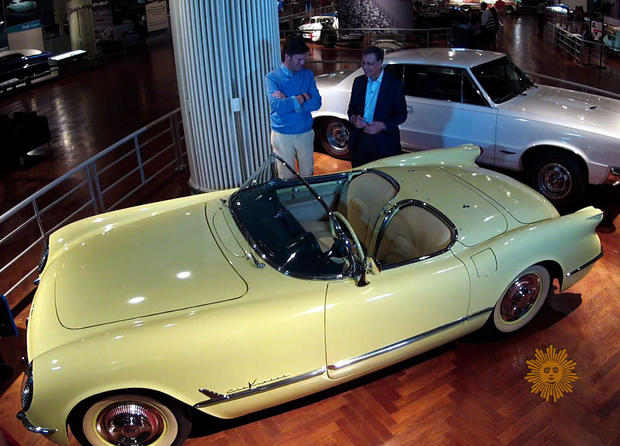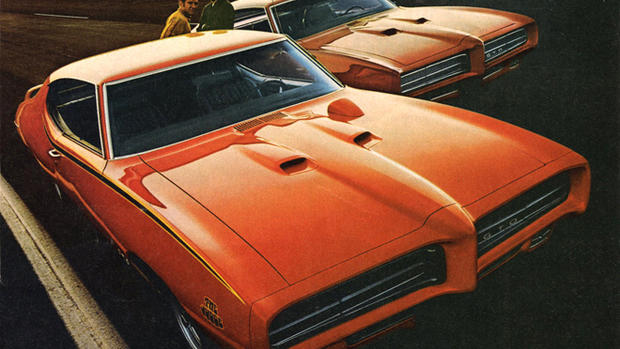Waxing nostalgic about America's car culture
(CBS News) America's car culture is the stuff of legend around the world. We all have our favorites. But what came first, the cars, or the culture they came to represent? We put Lee Cowan in the driver's seat, for our Sunday Morning Cover Story:
Americans love waxing nostalgic about our cars, though some look better in the rear view mirror.
From our first and the fastest, to our biggest and clunkiest, they're like pets with wheels.
But what if we took a look at ourselves - through our car's eyes instead? Not the creepy kind of Steven King-our-car-comes-alive idea, but illuminating history with a headlight?
That's just what Paul Ingrassia decided to do. "These are cars that had a definitive impact on how we live and think as people even today," he said.
In his book, "Engines of Change," Ingrassia lists what he says are America's 15 most influential cars - most of which have a home at The Henry Ford, a museum in Dearborn, Mich.
What he's compiled isn't a list of the nation's BEST cars - just the ones that changed our lives.
Some are obvious: The Ford Model T tops the list. It's credited for creating everything from the assembly line to the drive-through window. It put America on wheels - and the color black had no greater champion.
At the other end of the list is the Toyota Prius, another obvious choice given the impression - or LACK of impression - it left on the environment.
"It was a confluence of environmental consciousness plus pure economics," Ingrassia said.
If the Prius was about raising consciousness, the Pontiac GTO was about raising hell.
At a convention of GTO owners we found Ron Muck, who is happy his gas guzzler made the list.
"The GTO sometimes stands for Gas, Tires, and Oil!" he laughed.
Nevertheless, he said the GTO is without a doubt influential - it defined American muscle: "When you pull up to a stop light, people always want to challenge it because they hear this engine rumbling and roaring and they want to get out and see if they can beat it," Muck said. "And so far, no one has off the line!"
There are some cars on the list we only remember in song ("Boy, our old LaSalle ran great, those were the days!"). The LaSalle by General Motors made the list not because of Archie Bunker - but because it was the first car broadly marketed to those worried about style and status. The boxy Model T was too practical for those wanting to roar during the Roaring 20s.
By the 1950s, the country's mood was happy again. The war years had been tough, and nothing symbolized the country's new optimism better that the Chevy Corvette: flashy, unrestrained, proud.
"All of a sudden there's peace, there's prosperity. People want to let loose a little bit," said Ingrassia. "What else would you want to let loose in on the roads besides this?"
The Corvette even starred in its own TV series, "Route 66."
But America's upward mobility could soon be measured not only in speed, but in size - the size of tail fins.
The '59 Cadillac took America's tail fin race to new heights. They soared - just like America's reputation around the world.
"People idolized America - the sky's the limit, and anything can be done, and everything is larger than life. Guess what? The sky's the limit, and these are larger than life!" said Ingrassia.
But soon, the culture of being seen gave way to a counter culture of blending in - in a Bug.
When introduced by Volkswagen in the late Thirties, the actual name of the automobile was the Kraft Der Freude Lagen, or "The Strength through Joy car."
"It was a terrible name!" laughed Ingrassia.
The Volkswagen Beetle was Adolph Hitler's vision. He wanted something practical and functional. What he got was recreational, in more ways than one.
"The Microbus of the '60s and '70s were scenes of occasional acts of vehicular herbicide, shall we say," Ingrassia laughed.
Hitler and Hippies joined at four wheels - how ironic is that? Short of a peace sign, nothing symbolizes the movement better. And when Jerry Garcia of the Grateful Dead died in 1995, Volkswagen ran an ad that showed the face of a Microbus with a teardrop coming out of one of the headlights.
But the Volkswagens weren't the only celebrity cars of their day.
Enter the Ford Mustang - made popular by everyone from Steve McQueen to Mary Tyler Moore. The Mustang made "sporty" affordable.
"It just really captured this era when America's baby boomers were coming of age, getting their driver's licenses, going to college, and they wanted something different, really from their parents," said Ingrassia.
And when those baby boomers started to have families themselves, guess what came along to fill the void? The Chrysler Minivan. Yep, that's on the list too, not only because it replaced the crowded family station wagon but because it became a political force: It's the car that soccer moms drove.
But out of all the cars on Ingrassia's list, this one might surprise you the most, what Time called one of the worst cars ever made: the Chevy Corvair.
"I think the Corvair, hands down, is the second most influential car in American history after the Model T Ford," said Ingrassia. "The Model T put Americans on wheels. This car put America in the hands of lawyers!"
A young lawyer named Ralph Nader branded the Corvair as "Unsafe at Any Speed."
The Corvair defined product liability lawsuits, and government safety regulations were born.
But despite the stigma, the Corvair still has fans. Take Robert Marlow - he's had some 60 Corvairs over the years.
For all its faults, he believes the effect of the Corvair reached all the way to the White House.
"It's the only car that eventually influenced Presidential politics," said Marlow.
Remember the hanging chads in Florida in 2000? The Corvair's nemesis, Ralph Nader, certainly left his mark.
"Ralph Nader got 95,000 votes in the state of Florida that year," said Marlow. "Had Nader not been on the ballet, I think it's a solid argument that most of those 95,000 votes, or a good percentage of them, would have gone to Al Gore.
"Al Gore can blame the Corvair for losing the White House," he said.
There's more to Ingrassia's car culture list - some you might agree with, some not so much. What you WON'T find is the Camero, the T-Bird, or even the '57 Chevy.
"I mean, it's a great car, don't get me wrong, and it's a classic car of all time. But what about our life is different today, because that car existed?" said Ingrassia.
So let the debate begin. After all, your most influential car could have been a Gremlin - although you probably won't brag much about that.
For more info:
- "Engines of Change: A History of the American Dream in Fifteen Cars" by Paul Ingrassia (Simon & Schuster)

